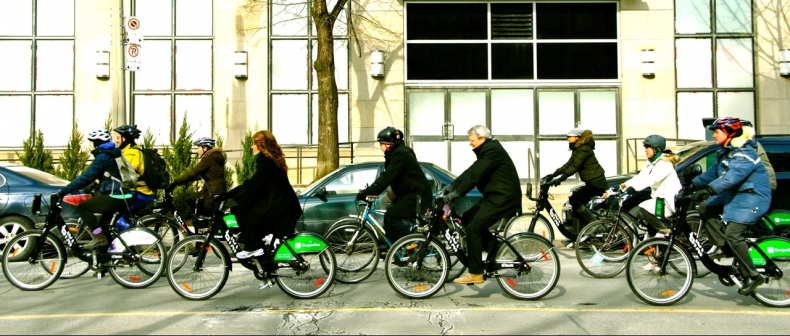
The Jarvis Street bike lanes have exactly two city meetings left before they turn to dust. In those two meetings (today and October 30) city councilors will hear deputations and have letters read to them from members of Cycle Toronto, local Jarvis Street residents and bike enthusiasts. But let’s do a (very) quick rehash some of the pivotal steps in the Jarv-saga and how we got here? In 2009 the Jarvis Street bike lanes were approved in a 28-16 vote under Mayor Miller’s reign, which meant shutting down the fifth reversible lane. But why? To rejuvenate the neighbourhood and improve the streetscape. Okay, good. The following year in July, spades and shovels get to work. It costs the city $59,000 to set-up the Jarvis bike lane infrastructure. In December 2010 Rob Ford gets elected as mayor. Interesting though, during his mayoral election campaign he says (when asked about the Jarvis Street bike lanes) he would not remove them because it would be a waste of money. Good to know. Well, let’s fast forward six months. In May last year, Mayor Ford’s administration — in a major, major back-pedal in the history of all major back pedalling– requested the elimination of the bike lanes and the return of the elusive fifth lane. We know the rest. Since then cyclists — through campaigns such as Save Jarvis — have been facing an uphill battle to bail out Jarvis from its impending doom.
Full disclosure here: I’m not a cyclist. I do not own a bike. I have been on Jarvis at its peak where cyclists (also known to motor vehicles as road-hogs) flitter about in droves and packs and pedestrians and cars are getting from A to B. My only claim to even remotely being a cyclist, is that I did at one point own a BMX bike when I was 10-years old. And I know how to change a bike tire. But for what it’s worth (from what I’ve observed), Jarvis Street accommodates all forms of traffic — pedestrians, cyclists and motor vehicles. It seems ripping out bike lanes goes against the grain of what the city is trying to achieve. At the moment there are multiple separated bike lane projects on-the-go splattered across Toronto: Sherbourne-Wellesley, Harbord-Hoskin, Richmond-Adelaide. The next painted bike lanes will be on Bay Street and York Mills and bike lanes have also been approved to be installed as part of transit projects on Sheppard & Eglinton in Scarborough. So why is the city removing a bike lane when they are knee-deep in other bike lane projects?
In April, Councillor Kristyn Wong-Tam held a public meeting at Jarvis Collegiate, called the Jarvis Cultural Corridor. Despite momentous council opposition, the results from this survey actually suggest that the local community prefers a safe cycling environment and wants Jarvis bike lanes to stay intact. The public consultation results showed 90 per cent of people who attended and filled out the survey wanted to keep the bike lanes on Jarvis; 66 per cent wanted to see a reduction in vehicle traffic; 87 per cent said they wanted the city to enhance pedestrian safety; and 72 per cent wanted new public space created. In recent phone call, councillor Wong-Tam was adamant that Toronto is falling behind other major cities when it came to implementing cycling infrastructure. “Jarvis is a cultural corridor. We should keep it that way — It works better as four lanes,” said Councillor Wong-Tam. “We are removing bike lanes when we should be installing them. The only thing that is stopping us from implementing more bike lanes is political will.”
During the tail-end of summer, New York City added four new one-way bike routes to help commuters get from east to west of the city, to try and make it a less suicidal trip. It’s all part of Mayor Bloomberg’s plan to add 255 miles of lanes and routes across the city. Cycling as a form of commuting is starting to have more appeal New Yorkers. A recent poll showed 66 per cent of New Yorkers said they thought bike lanes were a good idea; 27 per cent of residents called the lanes a bad idea. In Portland, The Oregon Department of Transportation will be adding new bike lanes across a one-mile stretch in the east end and aren’t afraid to throw some hard cash at the project (an estimated $3.8 million). Then of course there is cycling heaven, also known as the world capital of cycling: Copenhagen. It’s where North American cyclists go when they die. They boast safe streets (a cyclist will now ride 4.4 million kilometres before having an accident) and the idea of cycling is well supported by Copehagners: more than 36 per cent cycle to work or school; there are more cyclists in Greater Copenhagen than the entire United States.
Councillor Kristyn Wong-Tam. Photo by Justin Robertson.So is the City of Toronto failing its cyclists? According to Dan Egan from the city of Toronto, of course not. “Every North American city lags decades behind Copenhagen,” he said. “We are doing what we can with the resources we have. Part of the city’s bike plan, Egan said, is to increase bicycle ridership would include more bike parking, better links with transit and a bikeway network. “As a survey of successful bicycle friendly cities show you need much more than a bikeway network. The network consists of both on-road and off road facilities which need to be interconnected,” he said. “To focus just on bike-lanes is missing a huge part of the picture of what makes a city bike friendly.”
Toronto bike advocate and Save Jarvis campaign member Dave Meslin who is now the co-editor of Local Motion, came up with a few reasons why the Jarvis bike lanes should stay, but said its removal would be a tragedy for the city. “Right now, Toronto is the only city in North America that is ripping out major bike lanes. Bike lanes increase safety, but even more importantly they encourage more people to ride,” he said. “We spent hundreds of thousands of dollars on an Environmental Assessment, and on the installation. And now we’re going to spend a quarter million – to rip out those same lanes? The worst part is, there was no public consultation. This is being done against the will of the community”.
There has been copious amounts written about this issue, but this email exchange between a Torontonian “Kevin” and Mayor Rob Ford posted by Copenhagenize highlights how the city’s decision to remove Jarvis bike lanes is utterly absurd. During Ford’s response to Kevin (on the decision to remove Jarvis Street bike lanes) Ford claimed 95 per cent of commuters face longer commutes on Jarvis Street and said more than 15,000 commuters each day are “suffering” from longer travel times (for the sake of 600 additional cyclists). But wait — what about this report? Prior to the Jarvis installation a staff report (posted by Save Jarvis) showed significant motor vehicle delays along Jarvis. There have been updated traffic counts since then that have showed since the Jarvis installation traffic volumes remained the same even when cycling numbers have exploded.
It’s seems like an odd-ball move by Toronto City Council to have Jarvis removed. What about the hefty price tag of $272,000 plus the initial $59,000 cost to install it? Last I heard the City of Toronto did not have that kind of money to be throwing away like chump change. Imagine what the city could do with that kind of cashola they are spending to remove Jarvis? They could add more bike lanes elsewhere (and keep the existing Jarvis lanes to accommodate a growing community of cyclists). Maybe invest in an updated traffic count, or collision study, or public consultation? Maybe use the money to get informed before dropping the guillotine? At a time where other cities are progressing and building cycling-friendly urban environments, the removal of Jarvis bike lanes means we — Toronto — are shifting in the opposite direction. It’s a call that supports motor vehicles and in a city where half the population commutes by bike, the move is unprincipled. And that’s a call coming from someone who doesn’t commute or own a bike.
____
Justin Robertson is a freelance journalist from Toronto. His work has appeared in The Walrus, National Post and Toronto Standard. Follow Justin on Twitter @justinjourno
For more, follow us on Twitter @TorontoStandard and subscribe to our newsletter.














